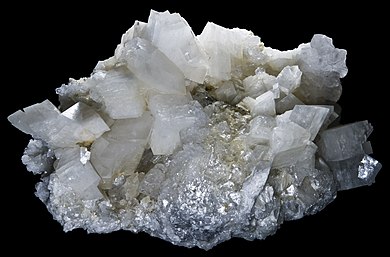Dolomite picture credit Wikipedia
Often overshadowed by its more famous counterpart, calcite, dolomite is a mineral that plays a vital role in the world of geology and beyond. This post delves into the multifaceted world of dolomite (CaMg(CO3)2), exploring its unique properties, presence in marble, and broader applications.
A Geological Overview
Dolomite, a carbonate mineral, is composed of calcium magnesium carbonate. It’s similar to calcite but with magnesium in its crystal lattice. This composition not only differentiates it from calcite but also imparts distinctive properties. It forms the bulk of the rock dolostone, previously referred to as dolomite, which can often be mistaken for limestone.
The Role of Dolomite in Marble Formation
In the context of marble, dolomite is more than just an addition; it can lead to the creation of dolomitic marble when present in significant amounts. This type of marble has some distinct characteristics:
- Increased Hardness: Dolomite is harder than pure calcite marble, making dolomitic marble more resistant to wear and tear.
- Altered Appearance: It often presents a slightly different color palette and texture compared to calcite-dominated marble.
Dolomite Applications and Uses
Dolomite’s utility extends far beyond its role in marble:
- Construction Material: Crushed dolostone (dolomite rock) is used as an aggregate in construction.
- Agricultural Use: It’s applied as a soil conditioner due to its magnesium content.
- Manufacturing Processes: Dolomite is involved in the production of glass, ceramics, and bricks.
Cultural and Historical Aspects of Dolomite
Dolomite has been a part of human history for centuries:
- In Ancient Architecture: Dolostone has been used in buildings and structures for its durability and aesthetic appeal.
- In Art: Some sculptors prefer dolomitic marble for its unique texture and workability.
Dolomite in Ecosystems
Dolomite plays a role in environmental processes:
- Carbon Sequestration: It can store carbon dioxide, contributing to the reduction of greenhouse gases.
- Aquatic Systems: Dolomite contributes to the buffering of pH in freshwater environments.
Caring for Dolomitic Marble
While similar to caring for calcite marble, dolomitic marble requires specific attention:
- Regular Sealing: To protect its surface from stains and erosion.
- Gentle Cleaning: Harsh chemicals can damage its finish and integrity.
Dolomite may not be as well-known as some other minerals, but its impact is undeniable. From forming beautiful variations of marble to its applications in numerous industries, dolomite is a mineral that deserves recognition for its contributions to our natural and cultural landscapes.




